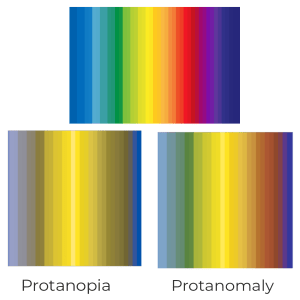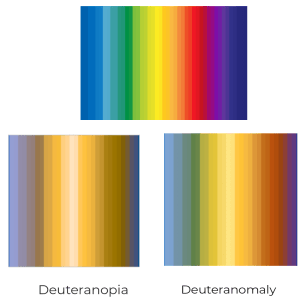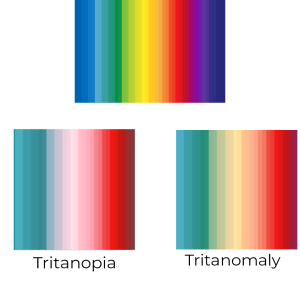We live in a beautiful world, teeming with energy and colours. Many of us admire the different hues seen in nature, and we pick a few of our favourites based on what it means to us.
But have you ever wondered how we are able to perceive all these colours?
A human eye has cells to recognize the three primary colours – red, green, and blue. Therefore the normal colour vision for a human is Trichromatic vision or Trichromacy.
But for some people, these cells may be more or less in number, causing a perception problem known as Colour Vision Deficiency.
A Colour Vision Deficiency or CVD is an X-linked chromosomal abnormality, and hence the males (one in 12) are more commonly affected than females (one in 200).
Causes of colour blindness
The causes can be either genetic or acquired.
Genetic:
The most common type of colour deficiency is the red-green deficiency, which is usually inherited or passed down from parents to their children.
A woman has 2 X chromosomes or XX, and a male has one X and one Y chromosome or XY. The gene of colour deficiency is present in the X chromosome. So if this gene is present in an X chromosome of a female, then the other X chromosome covers up for it. But she will be a carrier and can still pass it down to her children. But if a male having only one X chromosome has this gene, he will be colour deficient. Therefore males (one in 12) are more commonly affected than females (one in 200)
Acquired causes:
1. Diseases that affect the eye, the bloodstream, or part of the brain such as macular degeneration, optic neuritis, chronic alcoholism, leukaemia, glaucoma, Parkinson’s, Alzheimer’s, etc.
2. Medications: Certain medicines taken over a period of time can cause optic nerve dysfunction, resulting in colour vision problems. These include Hydroxychloroquine, ethambutol, certain high blood pressure and antipsychotic medications, etc.
3. Age: In old patients, the ability to see colour may be affected.
4. Toxic chemicals: Styrene is a neurotoxic chemical used in the manufacturing of plastic, pipes, rubber, insulation, fiberglass, etc., and its exposure more than the safe limit in the workplace has been associated with colour vision problems.
Types of colour deficiency
The human retina has three types of colour cells called cones, stimulated in specific ratios by different wavelengths of light coming from different coloured objects. On stimulation, they produce visual information that is sent to the brain via the optic nerve or the nerve that connects the back of the eye with the brain, and the coloured object is perceived.
In patients with colour deficiency, the ratio of stimulation between the three types of cones is affected, and therefore there is colour confusion.
As mentioned earlier, the most common colour deficiency is Red-Green colour deficiency. This can be of 4 types.
Protanopia:
These individuals entirely lack red cones and are red blind or cannot perceive the colour red. Instead, they see green and confuse between many colours like mid greens with some orange hues, blues with some reds, purples, dark pinks, etc.
Protanomaly:
These individuals have some red cones and can usually see some shades of red but they are often confused between light brown and dark green, orange and mid-green, etc.
Deuteranopia:
These individuals have no green cones and are green blind or cannot perceive the colour green. They see red or brown instead and often have confusion between mid reds and mid greens, bright greens and yellow, mid reds and mid browns, etc.
Deuteranomaly:
These individuals are mildly deficient in the green cones and can see some shades of green but are often confused between mid reds and mid greens, pink and light grey, bright green and bright yellow, etc.
Blue-yellow
Blue-yellow colour blindness is less common. The two types of colour blindness in this category make it difficult to distinguish between blue and green, and yellow and red.
There are two types of blue-yellow colour blindness:
Tritanopia:
These individuals lack blue cones and cannot perceive the colour blue. They see green instead. Yellow looks violet or light grey, and purple looks like dark red.
Tritanomaly:
These individuals have few blue cones and can usually see some shades of blue but are confused between blue and green, red and yellow.
Colour vision test
Since red-green deficiency is more common, we will see how it is diagnosed in the clinics.
This is done by a special test called the Ishihara colour deficiency test. This is only for diagnosing red-green colour deficiency.
It consists of a set of plates with dots of various colours and sizes. Within these dots are numbers that can be easily read by a person with normal colour vision. A person having some sort of red-green deficiency gets confused between the dots that make the numbers and the surrounding dots, therefore they read it incorrectly.
The full test consists of 38 plates but usually, a 24-plate Ishihara test is enough to diagnose the condition.
The prerequisites of doing Ishihara colour deficiency test are
1. Your doctor will probably take you out or near the window and make you take the test in natural light. This is because the warm indoor colours or bright phone background light may interfere with the sensitivity of the test.
2. The book is held 75m away.
3. It needs to be held up in front of the eyes and not put down on the table.
4. Usually, not more than 3 seconds are given for each plate to avoid visual cues from touching or tracing.
Although the Ishihara test is best taken in a doctor’s office, you can try our online test to check your colour vision. The result can be different in actuality because of ambient lighting and the background light of your device.
Is CVD curable?
Currently, there is no treatment for CVD that is inherited. If the CVD is due to any acquired condition, then it’s possible to restore your colour vision with treatment.
There are colour vision glasses to help colour deficient people see colours better but there are very few individuals who notice any change.
What are colour vision glasses?
A patient with a red-green colour deficiency may benefit from colour vision glasses. Studies show that a very small percentage of people with red-green deficiency report a mild improvement in their colour perception.
How do these glasses work?
Normally the eyes have three different cones as mentioned earlier. These cones receive different wavelengths of light, which correspond to red, green and blue.
The ratio of the three colours is sent by the cones to the brain, which processes it into millions of different hues. In patients with red-green deficiency, there is an excessive overlap of red and green colour cones, causing confusion and making certain colour hues indistinguishable.
The colour vision glasses help by selectively blocking out the wavelengths of light where there is excessive overlap.
This is the wavelength of light in which they have the most confusion. Therefore by blocking these wavelengths, these glasses help increase the contrast between the red and green colour signals, alleviating symptoms of colour confusion.
Here is a fun fact for you. Some of the celebrities with colour vision deficiency are Mark Zuckerberg, Christopher Nolan, Prince William, Bill Clinton, Keanu Reeves (to name a few).
A normal colour vision person might not understand what a colour deficient person goes through but the least that we can do is to be empathetic and to show a little care and concern. So let’s make an effort to help them in their everyday struggles with colors.
If you have any doubts or queries regarding this topic, please feel free to drop us a message.
References
1. https://www.nei.nih.gov/learn-about-eye-health/
eye-conditions-and-diseases/color-blindness/types-color-blindness



